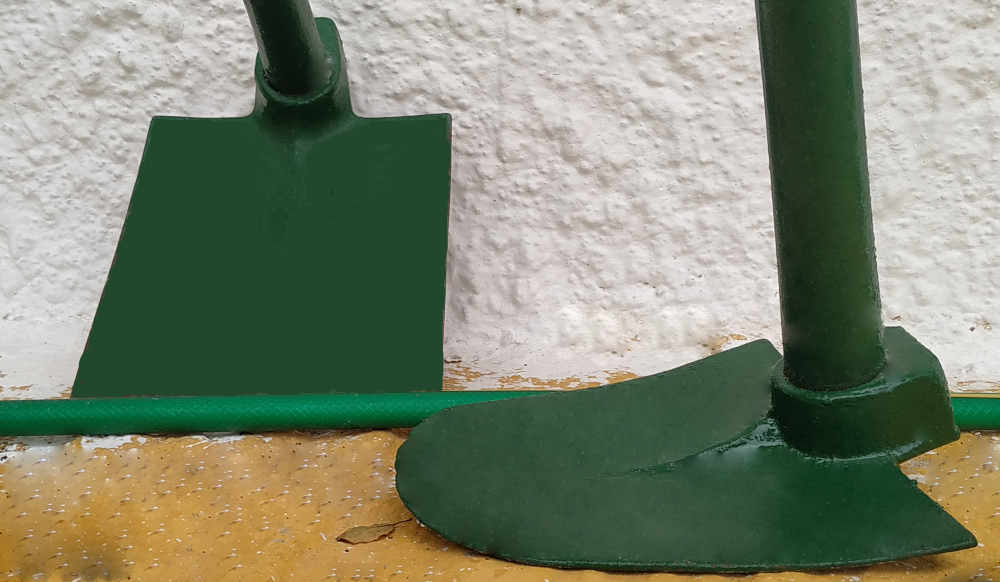Last Updated on March 25, 2024 by Editors
The main purposes of a garden hoe is light weeding, digging and tiling. However, garden hoe tools can help you with garden tasks in many ways. In this useful guide we present the most practical garden hoe types.
Garden hoes are one of the most essential tools for any home gardener. They are used to loosen soil, remove weeds, and make furrows for planting.
Table of Contents
What is hoe
The hoe tool is one of those gardening tools you need to have in your garden tool shed. It’s more of an agricultural tool than a gardening tool. Most hoes are garden hand tools consisting of a wide or narrow blade or a pointed head fixed perpendicular to a long or a small handle.
Garden hoes uses
A garden hoe is an essential multi-purpose garden tool that helps with digging, weeding, chopping roots, loosening and turning the soil, planting and cultivating.

Garden hoe types
Garden hoes come in various types. Each type has advantages or disadvantages, depending on soil type, weed size and head shape. Hoe tools are categorized according to their role. The most important garden hoe types are:
1. Grub hoe
The grub hoe tool, also known as grubbing hoe, is a digging hoe specialized for chopping small and medium roots. Grub hoe is also used to loosen packed soil. It’s a long handled hoe and has a heavy narrow head which enables this heavy duty garden hoe to chop and dig into tough hardened soil.
Most gardening hoes in this category are heavy duty grubbing hoes. A famous variant of the grub hoe is the field hoe which comes with a wider head end. Unfortunately, the wide head makes this gardening hoe slightly inefficient for deep weeding.
2. Draw hoe types

We already mentioned grub hoe and field hoe. Both of them belong to the draw hoe family. Garden hoes of the draw hoe type are used for drawing soil, thus the name “draw”. The user chops into the soil and then draws the head towards them. It’s a scraping and weeding hoe.
Besides grub hoe, eye hoe and grape hoe are the most common reliable hoe garden tool types in this category. Both of them are heavy duty garden hoes used to mound soil and dig up weeds. Additionally, their sharpened head is wider than the head of the grub hoe which makes them a better choice for weeding large areas and moving soil.
The lighter versions of draw hoe types are the collinear hoe, onion hoe and cultivator hoe. These ones are better for loose soil light hoeing.
Furthermore, there are some special draw type hoes like the Dutch hoe which has a triangular sharp pointed head. This one is long enough to get at the roots of weeds and you can use it for furrowing too.
3. Stirrup hoe types

The best garden hoe types to use for loose soil fast light weeding at ground level are those of the stirrup hoe category. They got their name because they have a double-edged blade that looks like a stirrup on a saddle. Depending on use, they feature a single edge sharp blade, a blade that is sharpened on both ways or a blade that neither of its sides are sharpened! This blade can pull small weeds easily with a back and forth scrubbing motion. Members of this hoe type are the oscillating hoe, the scuffle hoe, loop hoe, hula hoe, action hoe and the push pull hoe.
The push pull hoe tool is a lightweight hoe that has a V-shaped head with a sharp double-edged blade. Push pull hoe’s head has a pointed tip for removing deeply rooted weeds. It removes weeds on both the push and pull motion in dry loose soil.
4. Hand hoe types

Hand hoes are small hoe garden tools made for delicate weeding mostly. These are the best garden tools for effective weeding in narrow spaces, chopping small roots and can be used with ease for digging between large roots. Moreover, small hoes are lightweight and affordable compared to long-handled hoes. A good example of a sturdy and affordable one handed small hoe is the Korean hoe homi (sometimes named ho mi hoe or homi hoe).
In addition, there are other hand hoe types like the Nejiri and fork hoes. The fork hoe is a useful garden hand tool that is a combo of a hoe and a fork. Typically, the fork hoes they are small hoes. If you need a pitchfork to move material then avoid buying a fork hoe tool because it is more of a hoe or weeder tool than a pitchfork.
5. Wheel hoe types

The wheel hoe is more a cultivator than a hoe tool and its use is intended for big vegetable gardens. Out of all hoe types, this is a special one, as its name suggests, it’s a garden hoe tool that comes with one or more wheels. Generally, there are two models of the wheel hoe tool: a two wheels hoe model which offers better stability and has a very fast weeding ability, and a single wheel hoe that is inexpensive.
Which garden hoes are the best for hard rocky soil?
I live on a small farm that has very hard and rocky soil. My garage is full of various garden hoe types with broken handles and heads. I used them wrongly and had to learn the hard way that I needed heavy duty, tough hoes to break the ground and penetrate into my garden’s hardened, rocky soil with ease. The choice was obvious: A heavy duty garden hoe like the grub hoe for big swings and deeper weeding and an eye hoe or a grape hoe for wider weeding.
On the contrary, durable light weeding hoes like the collinear hoe or the push pull hoe, are very good choices for loose and cultivated soil. For delicate weeding and digging in small raised flower, herb or vegetable beds, consider buying a small, light and strong hand toe like the Korean mi hoe.
Which is the best place to buy garden hoes?
 The best place to find and buy hoes is your local hardware store. Pay them a visit to find the one that suits you. We recommend though, that you keep an eye on the following:
The best place to find and buy hoes is your local hardware store. Pay them a visit to find the one that suits you. We recommend though, that you keep an eye on the following:
- Make sure that the handle’s diameter matches with the head’s hole, otherwise the head will not fit to the handle.
- Prefer a round hoe head.
- Avoid buying one with a very thin blade, especially Chinese ones. Usually, their metal is cheap and not sturdy enough, resulting most of the times in a bent or broken hoe head after the first 3-4 uses.
- Choose a head that has an easy-to-sharp blade.
- The head has a small hole to screw (or pin) the hoe to the handle and hold the handle in place. This hole must be round and the included screw must not be a flimsy one. Stainless steel screws are good enough.
- A high-quality handle material will resist cracking and weathering. Decent quality wooden handles will do the job, pick a handle with a smooth finish and comfy grip. Pay attention to the handle’s length, make sure it’s the right one for your height and check that the wood grain pattern on the handle is straight.
On the other hand, if you don’t have any local retailer in your neighborhood you can always buy from online stores. For example, at Amazon there is a big collection of hoes, hoes’ heads and handles for every budget and every need.
Garden hoes maintenance
Garden hoes require the usual garden hand tool maintenance. Additionally, they need some special care because they have an edge that is required to be sharp.
- Remove the dust or mud and clean your hoes with water after each use.
- Make use of a cloth to dry them well.
- Inspect each hoe and make sure that their head is attached securely to the handle.
- A sharp blade is very important for optimal results. Remove any rust with a sandpaper and then use a sharpening tool like a hand file to sharpen the blade if it’s dull.
- Store your garden hoes in a dry place like a garden tool shed or perhaps a storage cabinet.
- If the handles of the hoes are wooden then, once a year, use a finishing oil to finish them.
As an Amazon Associate I earn from qualifying purchases. We may get commissions for purchases made through links in this post.

